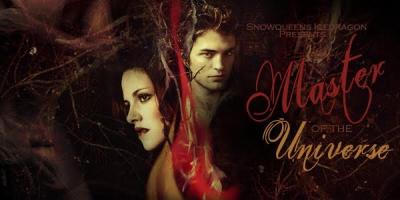 By DENIELLE LEONG
By DENIELLE LEONG
alltherage@thestar.com.my
IMAGINE this: Bella Swan settles down with an average Joe in the Upper East Side, sans sparkly vampires. Meanwhile, in a galaxy far, far away, Harry Potter is battling the Dark Side as a Jedi Knight.
“Preposterous!” you might say, but it’s really nothing out of the ordinary in the strange world of fan fiction, where people use the characters and universe of their favourite stories to create their own works of fiction.
Known simply as fanfic, this genre of storytelling has actually been around for quite some time. Some even say Charlotte Brontë and her siblings pioneered it when they started writing fantasy adventures based on Arthur Wellesley, 1st Duke of Wellington – an actual person. In today’s world, that’s known as real-person fanfic – very popular among One Direction and Kpop fans.
(Related story: Check out the top 5 weirdest fanfics)
And in the 70s, of course, we had the Star Trek-based Spockanalia fanzine, which was basically filled with fanfic.
But thanks to the Internet, e-books and tablet devices, fanfic has really started to grow like crazy in recent years, including in Malaysia. Even Amazon has created a platform just to sell fanfic (read here).
(Related story: What about copyright laws?)
Back in the day, even if a publisher did want to print your fanfic, would anyone buy it? With stories like Goku from Dragon Ball-Z falling in love with Anne Frank and fighting Adolf Hitler together, probably not.
But now, people can spend hours browsing through popular fanfic sites like FanFiction.net and Archive Of Our Own (AO3), writing and reading stuff for free – and, thanks to tablet devices, you don’t have to look like a geek (or a freak) holding a fanfic magazine on the train ride to work.
That’s basically how E. L. James’ Fifty Shades Of Grey – originally published episodically on the Internet as Twilight erotica fanfic – became a best-seller. After building a following online, James released her collected work as e-books, with Bella Swan and Edward Cullen’s characters given new names. The discreet nature of e-reading devices quickly helped gain James’ risque work a bigger audience, which then led to the whole series being published.
For the authors
Clearly, it’s the authors of fanfic who have benefited most from the latest in e-publishing technology because let’s face it – they’re really not writing for an audience. It’s something they do more for themselves.
“Perhaps it’s a waste of time, but it’s just something I enjoy doing. It gives me the freedom to add my personal touch to the story,” said Nurhanani Fazlur Rahman, who maintains five separate Tumblr blogs, each dedicated to a character from A Song Of Fire And Ice, the books that inspired HBO’s Game Of Thrones.
Nurhanani spends hours every day on writing, doing research and having Skype discussions with other collaborators around the world (more on that here).
The most common reason people write fanfic, according to Nur Hafizah Johari, 17, is to fill in some of the gaps in their favourite stories.
“A lot of people let their minds wander to the what-ifs or what-nows after reading a book. Fan fiction is just putting those thoughts in writing,” said Hafizah, who enjoys writing Harry Potter and Glee fanfic.
For others, like Nur Elyna Mahzan, 17, fanfic is just a way to let your mind wander a little. The Form Five student wrote her first fanfic last year, about a fight between Kpop bands B.A.P. and EXO.
“It was originally just a thought about how these two groups would be like in a fight since they had quite a rivalry back then,” she explained. “I liked the response I got so I continued writing.”
Among authors of the original works, however, opinion is divided. Some find it harmless, some find it disrespectful.
Some, like J. K. Rowling, are simply concerned by the extremely explicit nature of some fanfic genres. George Lucas is known to send “cease and desist” letters over pornographic fanfic.
In a blog post in 2010, A Song Of Fire And Ice author George R. R. Martin wrote: “Consent, for me, is the heart of this issue. If a writer wants to allow or even encourage others to use their worlds and characters, that’s fine. Their call.
“Myself, I think the writers who allow fan fiction are making a mistake.”
(Related story: Find out what famous authors think…)
Fan-fiction 101
FOR the uninitiated, fan fiction might seem like a strange, foreign world of wizards, Jedi warriors, Dothraki queens and glittery vampires all lumped together. So here are a few basic terms you should know before exploring this universe:
> Canon – The original literary pieceused as reference for fan-fiction. Pre-canon and post-canon fan-fictions are stories set before or after the original storyline respectively.
> Crossover – Fan fiction that incorporates characters from different stories. For example, Jedi Spock (pic). Vulcan Death Grip + Force Choke = Awesomeness.
> Roleplay – A collaborative effort where fans roleplay as specific characters in writing a story. A writer contributes several paragraphs, which will then be continued by his or her writing partner. (More on page 4)
> Shipping – It’s all about relationships. Fans get to play cupid and pair characters together. And this is how portmanteaus like Caskett, as in Castle and Beckett, come to exist. Anakin Skywalker and Hermione Granger, anyone?
Fanfic genres
> Fluff – Rainbows and unicorns populate these fanfics. Everyone’s happy all the time!
> Angst – Pretty much the polar opposite of fluff.
> Crack – Anything can happen here. Cows falling from the sky? Chuck Norris on a blind date with a werewolf? Totally acceptable.
> Mpreg – It delves into the unknown world of male pregnancy. You really don’t wanna know…




Tell us what you think!